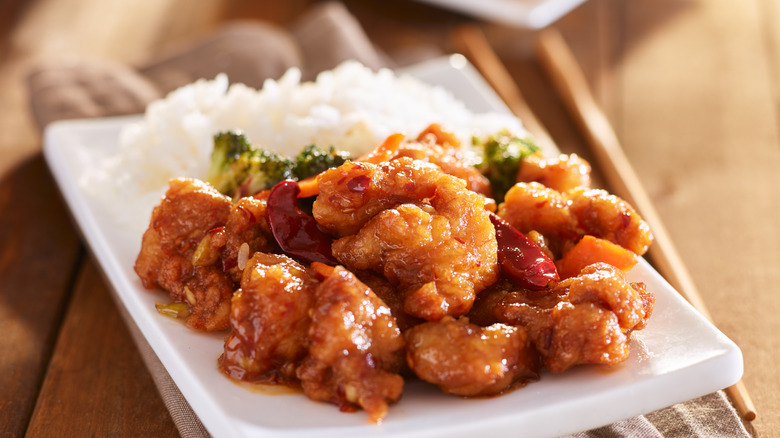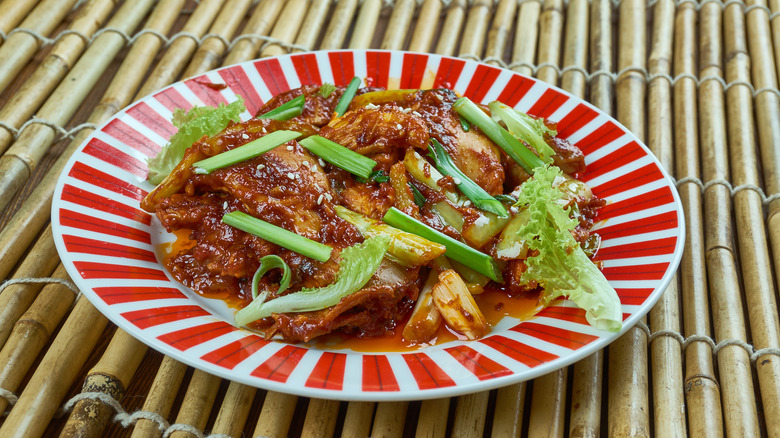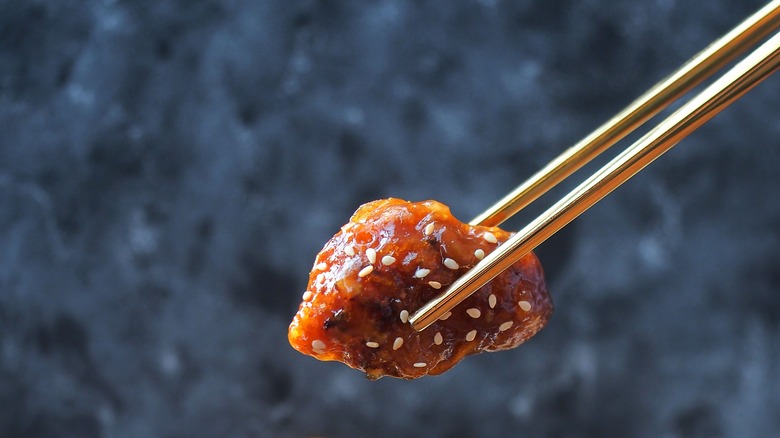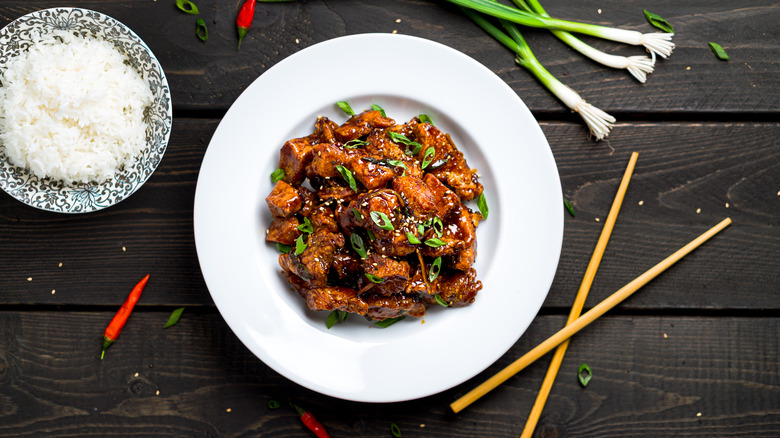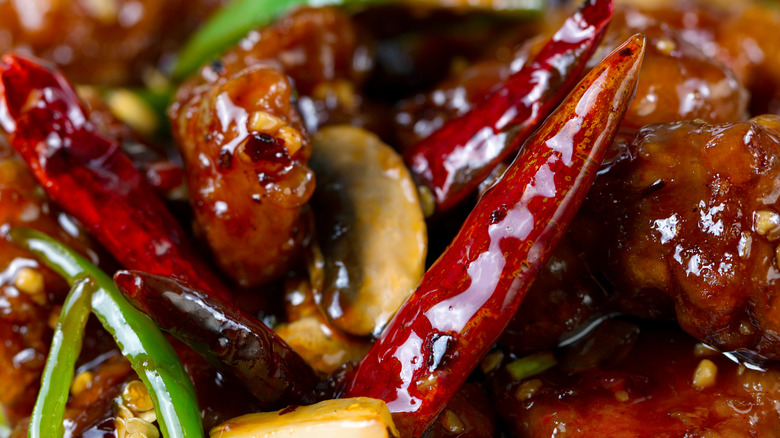Sweet & Sour Chicken Vs General Tso: Everything You Need To Know
When you're eyeing up the chicken section on the menu at your favorite Chinese takeout spot, you'll typically see lots of variations on a theme. From orange chicken to sesame chicken to kung pao chicken, many offerings see chicken battered in a coating and glazed in a sticky sauce that marries sweet, sour, and spicy flavors. In fact, two of the most popular chicken entrées — General Tso's chicken and sweet and sour chicken — both fit this description to a T.
Peter Som, an award-winning fashion designer, culinary creator, and lifestyle expert, explained the difference between these two recipes in an exclusive interview with Mashed. In addition to his success in the fashion world, Som is a prolific recipe developer and food writer with bylines in publications like Bon Appétit, Food And Wine, and The Purist. He is currently writing a cookbook, "Family Style," which is set to be published in winter 2025.
Per Som, both dishes are indeed typically battered and fried the same way, with a similarly sticky final texture. They also share a similar history that has far more to do with their presence in America than their Chinese roots. That said, there are a number of factors that divide the two dishes. Here's everything you need to know about their commonalities and essential differences, so you can pick the Chinese chicken dish that's best for you.
What is sweet and sour chicken?
As its name suggests, sweet and sour chicken sees chicken chunks coated in a moreish sauce marrying sweet and sour flavors. To make sweet and sour chicken, one typically begins by breading chunks of chicken in a light coating of egg whites and cornstarch. The chicken chunks are then fried and finally tossed in the namesake sweet and sour sauce.
The sauce usually gets much of its sweetness from canned pineapple — both the fruit and the juice — as well as rich brown sugar. The acidity in the dish typically comes from white distilled vinegar, though some versions use white rice vinegar or black rice vinegar. And one final ingredient lends additional sweetness, sourness, and umami richness, though it may come as a surprise: ketchup. This essential addition is a testament to the Chinese-American nature of the dish, and it lends both some sweetness as well as tanginess to the final sauce.
There are, of course, variations on this theme. Some versions of sweet and sour chicken also contain soy sauce, which adds even more umami and just the right amount of salt to balance the dish. Often, culinary creator Peter Som adds, you'll also find bell peppers added to the recipe.
What is General Tso's chicken?
General Tso's chicken is another mainstay of American Chinese food menus, and it frequently begins in the same way as sweet and sour chicken: with chunks of poultry tossed in a cornstarch batter that, once fried, end up with a light and crispy coating. Much as with sweet and sour chicken, General Tso's chicken is then tossed in a sticky, sweet sauce, this time made with rice vinegar, soy sauce, hoisin sauce, and sugar. Ginger, garlic, and chili flakes add more depth to the flavor. And it's worth noting that you'll find no ketchup in this sauce.
General Tso's chicken also frequently contains veggies, according to culinary creator Peter Som. "There are variations," he says, "but in general you can find tomato and broccoli in General Tso's." You'll also frequently find dried whole chilies in General Tso's chicken — usually Tien Tsin chili peppers — which infuse the dish with a mild heat ... unless you chomp down on one whole!
Neither sweet and sour chicken nor General Tso's chicken is authentically Chinese
The word "authentic" has proven problematic in culinary circles of late, but suffice it to say if you order either sweet and sour chicken or General Tso's chicken in China, it's unlikely you'll be presented with anything that looks familiar to you. Unlike the orange-colored sweet and sour chicken you'll find in America, Chef Andrew Wong tells CN Traveller, the dish in China boasts a far darker hue thanks to the use of black vinegar to add the acidity that typically comes from ketchup.
"Sweet and sour chicken came to the states in the early 20th century with Chinese migrant workers working on the railroad," according to culinary creator Peter Som. But the recipe gradually became more Westernized, with the pungency and bitterness of the original reduced to suit American palates. General Tso's chicken, meanwhile, arrived in the U.S. thanks to chef Peng Chang-kuei, who, after crafting a similar dish in the '50s in Taiwan, immigrated to New York and decided to sweeten the traditional dish to appeal to his American customers.
Both dishes have roots in the cuisine of Hunan
While both sweet and sour chicken and General Tso's chicken as we know them are really Chinese-American creations, they share roots in the cuisine of the province of Hunan, the birthplace of the late Communist Party leader Mao Zedong.
"General Tso's chicken has origins in Taiwan, but [those] trace back even further to Hunan," explains culinary creator Peter Som, who adds that both dishes feature the "characteristic balance of sour, savory, and salty" found in Hunan cuisine albeit "with General Tso's leaning more spicy and sweet and sour more on the sweet side."
That fact that both dishes became popular in the U.S. is due in large part to waves of Chinese immigrants arriving during the California Gold Rush. From 1852 to 1882, over 300,000 Chinese laborers came to the U.S., bringing flavors from their homeland — and their own recipes — along with them. These recipes were later adapted for American palates. Their links to authentic Hunanese cuisine are tenuous at best. True Hunanese cuisine is "the best cooking in all China," according to Tony Hiss, a writer for The New Yorker who penned that as part of his introduction in "Henry Chung's Hunan Style Chinese Cookbook," published in 1978 (via Silky Kitchen). According to Chung, who owned a Hunan restaurant in San Francisco, this stems in large part to the region's love of spice, which is essential in the subtropical central Chinese climate to cool the body temperatures of its inhabitants.
The original General Tso's chicken was born in the '50s and adapted for American palates
While a dish dubbed General Tso's chicken does indeed exist in China, it's far from being traditional, as some may be led to believe. What chef and author Fuchsia Dunlop categorizes as "the most famous Hunanese dish in the world" is little-known in Hunan itself (via NPR). When Dunlop lived in Hunan in 2003, she said she "scoured restaurant menus for it in vain."
She discovered that the dish, while named for a 19th century Hunanese general, General Tso Tsung-t'ang, actually dates to the aftermath of the Chinese civil war, when Nationalists abandoned Communist China for Taiwan. Among those moving to the island was chef Peng Chang-kuei, who began cooking a version of the dish in the 1950s. He told Dunlop in 2004 that, despite boasting typically Hunanese flavors, General Tso's chicken was a creation that "did not preexist in Hunanese cuisine" — and moreover, the recipe back then would likely be unrecognizable to American fans of the dish today.
Indeed, writer Jennifer 8. Lee, who co-produced the documentary, "The Search for General Tso," said she found that the original dish was not deep-fried and often had skin and bones. And perhaps most importantly, it was not sweet. It wasn't until Chang-kuei moved to New York in 1973 that he adapted the previously "heavy, sour, hot, and salty" dish to one with more sweetness in hopes that it would appeal to the American palate.
Hong Kong style of sweet and sour chicken is most familiar in U.S.
Sauces combining sweet and sour flavors can be found throughout China, though predominantly in the provinces of Hunan and Guangdong. That said, the Chinese iterations of dishes marrying these flavors are miles apart from what we'd typically find in the U.S.
First off, sweet and sour sauces in Hunan are usually served as an accompaniment for fish, not chicken — with emphasis on the word "accompaniment." These sauces are typically offered alongside the dish as a dip, and they often boast more bitterness than the American versions. And of course, these sauces don't rely on tomato ketchup for flavor. Instead, they take advantage of the sweetness of fruit and the acidity of vinegar to get that namesake flavor combo.
It's the Americanized version that most diners expect to find when referring to sweet and sour chicken, and it's often called Hong Kong style. That simply means you're getting the version that's been altered by outside influences, particularly from the Western culture.
Both sweet and sour chicken and General Tso's chicken are typically deep-fried
Despite the differences between the two dishes, the same base technique is used to make General Tso's chicken and sweet and sour chicken. In both cases, the chicken is first coated in a thin batter made with cornstarch and egg white. In some recipes, this coating is further seasoned with ingredients like sugar, soy sauce, white vinegar, or ginger. Using cornstarch in place of flour doesn't just make the recipe gluten-free; it also makes the coating thinner, which gives you a finished product that's crispier and lighter than most American fried chicken dishes.
Once the chicken has been coated, it's typically deep-fried before being tossed in the sweet, sticky sauce. Keeping the sauce on the thicker side helps the chicken stay crispier longer; thinner sauces will have a tendency to make the coating soggy and far less appetizing.
General Tso's chicken has slightly more calories
Deep-fried chicken coated in a sweet sauce is certainly not a diet food. Both sweet and sour chicken and General Tso's chicken are fairly calorie-dense offerings on Chinese food menus. Of course, the calorie content of each dish will vary widely depending on where you source it, with different brands of store-bought General Tso's chicken containing anywhere from 220 calories to 493 calories per cup.
In the interest of keeping things fair, we compared the dishes as prepared by one restaurant chain: Panda Express. Here, one 5.70-ounce serving of General Tso's chicken contains 330 calories and 12 grams of fat while the same-sized serving of sweet and sour chicken contains 300 calories and the same amount of fat. The discrepancy is likely due to the fact that while sweet and sour chicken aptly contains slightly more sugar than General Tso's, the latter contains way more protein, so despite being a bit more calorically dense, it's actually the healthier choice.
General Tso's chicken is typically spicier
When it comes to choosing between sweet and sour chicken and General Tso's chicken, fans of spicy food would do well to opt for the latter. "General Tso's chicken is known for having spice," culinary creator Peter Som says. Indeed, most recipes feature chilies in some form, whether that be flakes, a paste, or dried chilies.
While you'll find loads of variation, General Tso's chicken typically capitalizes on the heat and flavor of dried Tien Tsin chilies. These Chinese chilies pack a wallop of heat, boasting between 50,000 and 75,000 Scoville heat units (as compared, for example, to the 2,500 to 8,000 Scoville units for jalapeños). That said, don't expect this dish to blow your palate clear away: The chilies are typically added whole into the dish, so as long as you push them off to the side of your plate and don't pop one into your mouth, they'll add a pleasant but relatively mild heat to the dish.


